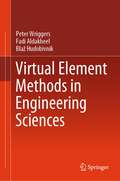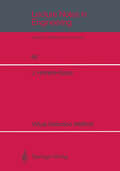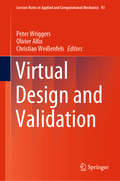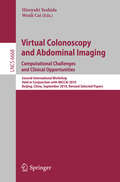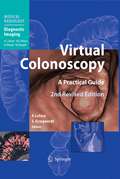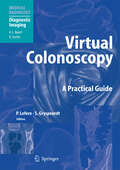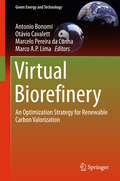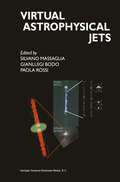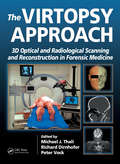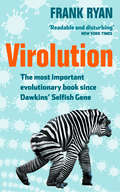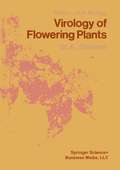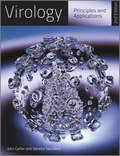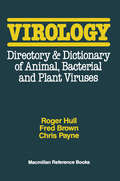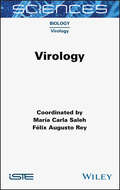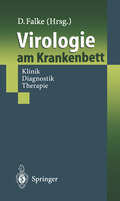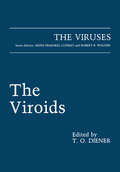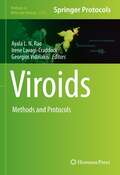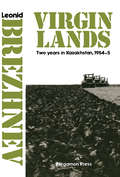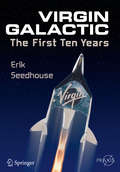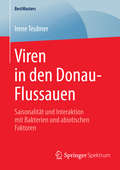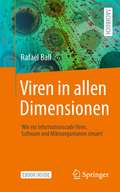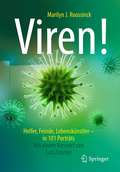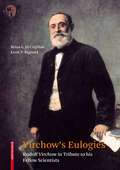- Table View
- List View
Virtual Element Methods in Engineering Sciences
by Peter Wriggers Fadi Aldakheel Blaž HudobivnikThis book provides a comprehensive treatment of the virtual element method (VEM) for engineering applications, focusing on its application in solid mechanics. Starting with a continuum mechanics background, the book establishes the necessary foundation for understanding the subsequent chapters. It then delves into the VEM's Ansatz functions and projection techniques, both for solids and the Poisson equation, which are fundamental to the method. The book explores the virtual element formulation for elasticity problems, offering insights into its advantages and capabilities. Moving beyond elasticity, the VEM is extended to problems in dynamics, enabling the analysis of dynamic systems with accuracy and efficiency. The book also covers the virtual element formulation for finite plasticity, providing a framework for simulating the behavior of materials undergoing plastic deformation. Furthermore, the VEM is applied to thermo-mechanical problems, where it allows for the investigation of coupled thermal and mechanical effects. The book dedicates a significant portion to the virtual elements for fracture processes, presenting techniques to model and analyze fractures in engineering structures. It also addresses contact problems, showcasing the VEM's effectiveness in dealing with contact phenomena. The virtual element method's versatility is further demonstrated through its application in homogenization, offering a means to understand the effective behavior of composite materials and heterogeneous structures. Finally, the book concludes with the virtual elements for beams and plates, exploring their application in these specific structural elements. Throughout the book, the authors emphasize the advantages of the virtual element method over traditional finite element discretization schemes, highlighting its accuracy, flexibility, and computational efficiency in various engineering contexts.
Virtual Design and Validation (Lecture Notes in Applied and Computational Mechanics #93)
by Peter Wriggers Olivier Allix Christian WeißenfelsThis book provides an overview of the experimental characterization of materials and their numerical modeling, as well as the development of new computational methods for virtual design. Its 17 contributions are divided into four main sections: experiments and virtual design, composites, fractures and fatigue, and uncertainty quantification. The first section explores new experimental methods that can be used to more accurately characterize material behavior. Furthermore, it presents a combined experimental and numerical approach to optimizing the properties of a structure, as well as new developments in the field of computational methods for virtual design. In turn, the second section is dedicated to experimental and numerical investigations of composites, with a special focus on the modeling of failure modes and the optimization of these materials. Since fatigue also includes wear due to frictional contact and aging of elastomers, new numerical schemes in the field of crack modeling and fatigue prediction are also discussed. The input parameters of a classical numerical simulation represent mean values of actual observations, though certain deviations arise: to illustrate the uncertainties of parameters used in calculations, the book’s final section presents new and efficient approaches to uncertainty quantification.
Virtual Colonoscopy and Abdominal Imaging: Second International Workshop, Held in Conjunction with MICCAI 2010, Beijing, China, September 20, 2010, Revised Selected Papers (Lecture Notes in Computer Science #6668)
by Hiroyuki Yoshida Wenli CaiThis book constitutes the thoroughly refereed post-conference proceedings of the International Workshop on Computational Challenges and Clinical Opportunities in Virtual Colonoscopy and Abdominal Imaging, held in conjunction with MICCAI 2010, in Beijing, China, on September 20, 2010. The 19 revised full papers presented were carefully reviewed and selected from 26 submissions. The papers are organized in topical sections on CT colonography CAD, abdominal imaging, and virtual colonoscopy.
Virtual Colonoscopy: A Practical Guide (Medical Radiology)
by Y. Arai D. Bielen F. Booya D. Burling F. Cerri A. H. Dachman A. H. Vries H. Fenlon J. G. Fletcher S. Gryspeerdt L. S. Guimaraes S. Halligan G. Iinuma A. Laghi P. Lefere A. Maier T. Mang B. G. McFarland R. Mendelson M. Miyake N. Moriyama K. J. Mortelé Y. Muramatsu D. Murphy E. Neri P. R. Obara A. S. Odulate M. Raquel Oliva P. Pokieser W. Schima J. Stoker S. A. Taylor F. Turini K. Uchida J. Yee H. Yoshida M. E. ZalisPhilippe Lefere Stefaan Gryspeerdt A. L. BaertRapid progress in the technique and practice of virtual colonoscopy as well as the conti- ing clinical high interest for this radiodiagnostic procedure made this second edition, only 3 years after the publication of the ? rst edition of this successful volume, necessary. This new edition includes the latest study results and technical developments of this exciting noninvasive diagnostic modality for the evaluation of the colon. The technical presentation and lay out of the text and of the many new illustrations are impeccable. The editors were again able to ensure the collaboration of many international leaders in the ? eld and the book offers a very comprehensive overview of all aspects and issues of CT colonography with a focus on how to perform practically this examination, which requires meticulous technique starting from rigorous preparation, then the conduct of the study itself, and ? nally the interpretation of the results. I am very much indebted to the editors and the collaborating authors for preparing this outstanding volume in a record short time period, which enabled them to include the latest technical advances in this rapidly evolving important radiological method. It is highly recommended to general and gastrointestinal radiologists as well as gast- eneterologists as a most welcome update of their knowledge and as a practical guide in their daily practice. I am convinced that this second edition will meet the same success with our readership as the ? rst one.
Virtual Colonoscopy: A Practical Guide (Medical Radiology)
by Philippe Lefere A. L. Baert Stefàan GryspeerdtVirtual colonoscopy, or CT colonography, is a novel and rapidly evolving technique for the detection of tumoral lesions in the colon. It promises to be of great value as a screening tool for both colorectal cancer and its adenomatous precursor. With contributions from several leaders in the field, this book addresses all the important issues relating to virtual colonoscopy. There is a particular focus on practical aspects: how to start virtual colonoscopy in a department, the regular preparation, the importance of fecal tagging, how to reduce the preparation, how to obtain optimal colonic distension, and the correct scanning parameters. Imaging characteristics and pitfalls are considered in detail, with an extensive pictorial review of difficult lesions, and the importance of computer-aided diagnosis is discussed. This book will be invaluable to every radiologist seeking information on how to perform the exciting technique of virtual colonoscopy.
Virtual Biorefinery: An Optimization Strategy for Renewable Carbon Valorization (Green Energy and Technology)
by Antonio Bonomi Otavio Cavalett Marcelo Pereira da Cunha Marco A. P. LimaThis book presents a concise framework for assessing technical and sustainability impacts of existing biorefineries and provides a possible road map for development of novel biorefineries. It offers a detailed, integrated approach to evaluate the entire biomass production chain, from the agricultural feedstock production and transportation, to the industrial conversion and commercialization & use of products. The Brazilian sugarcane biorefinery is used as a case study; however, the methods and concepts can be applied to almost any biomass alternative. Chapters explore the main issues regarding biorefinery assessment, including feedstock production and transportation modeling, biofuels and green chemistry products, as well as assessment of sustainability impacts. This book is a valuable source of information to researchers in bioenergy, green chemistry and sustainability fields. It also provides a useful framework for government agencies, investors and the energy industry to evaluate and predict the success of current and future biorefinery alternatives.
Virtual Astrophysical Jets: Theory Versus Observations
by Silvano Massaglia Gianluigi Bodo P. RossiThese proceedings are the result of a three-day meeting held in Oogliani (Italy), on October 2-4 2003, whose title was "VIrtual Astrophysical Jets 2003". Our goal in convening this meeting was to gather some of the scientists among the most active in the field of numerical simulations and modelling of astrophysi cal jets. For keeping the participants close to the "real world", we also invited a few observers to give up-to-date reviews outlining the state-of-the-art of jet observations. The principal aim of the meeting was thus to present and critically discuss the state-of-the-art numerical simulations, analytical models and laboratory ex periments for reproducing the main aspects of astrophysical jets and compar ing them with observations. The discussion has been focused on the following topics: • Observations and intepretions of jets from young stars and AGNs, comparisons of models with observations; • MHO accelerations of jets: steady self-similar models, MHO numerical simula tions of time-dependent accelerations mechanisms; • Jet stability and interaction with the ambient: formation of knots in YSO jets, jet survival to instabilities, deceleration of relativistic jets in FRI sources, simulations of jets-IGM interactions, jets propagation and galaxy formation; • Numerical codes and their validation: relativistic MHO codes, comparisons among different numerical schemes, jets in the laboratory and code validation. These topics have been discussed intensively during the meeting, and the out come of these discussions is presented in this volume. The contributions have been divided in five sections.
The Virtopsy Approach: 3D Optical and Radiological Scanning and Reconstruction in Forensic Medicine
by Michael J. Thali Richard Dirnhofer Peter VockCharred, badly decomposed, or mummified corpses, as well as those restrictions forced upon coroners by certain religious sects, often make autopsies impossible to perform. In addition, lack of manpower among the personnel charged with performing autopsies frequently creates a backlog of cases in the coroner‘s office. This delay increases the likeli
Virolution: Die Macht Der Viren In Der Evolution
by Frank RyanThe extraordinary role of viruses in evolution and how this is revolutionising biology and medicine.
Virology: Principles and Applications
by John Carter Venetia SaundersThe second edition of Virology is an accessible introduction designed to enable students to understand the principles of virus structure, replication and genetics. The aim of this book is to help the reader appreciate the relevance of virology in the modern world, including the fields of vaccines, anti-viral drugs and cancer. There is also a chapter on prions. The second edition has been extensively revised and updated to reflect the many developments in virology and offers deeper insights into the subject. Newly-discovered viruses are discussed and there is an additional chapter on the influenza virus.
Virology: A Directory and Dictionary of Animal, Bacterial and Plant Viruses
by Roger Hull Fred Brown Chris PayneA comprehensive dictionary describing all known viruses of animal and plants. It describes terms commonly used in virology as well as cell lines and chemicals used in organizations and the techniques applied in this work. Equations, formulae and definitions of units in virology are covered.
Virology
by Maria Carla Saleh Felix Augusto ReyViruses interact with all forms of life and have shaped evolution for 4 billion years. The COVID-19 pandemic highlights the importance of conducting scientific research into viruses to understand the interactions between them and their hosts. Virology is made up of eight chapters, all of which have been written by outstanding female virologists, emphasizing women's fundamental role in all aspects of science. It summarizes our current knowledge about the biology of viruses in general and analyzes the specific features of several ones of medical, veterinary and agricultural importance. Genome replication strategies of different virus families are covered, as well as strategies for survival within their hosts by counteraction of the cellular innate antiviral responses. Attention is also given to viral strategies for efficient dissemination in nature, as well as the evolution of a select group of viruses.
Virology
by Maria Carla Saleh Felix Augusto ReyViruses interact with all forms of life and have shaped evolution for 4 billion years. The COVID-19 pandemic highlights the importance of conducting scientific research into viruses to understand the interactions between them and their hosts. Virology is made up of eight chapters, all of which have been written by outstanding female virologists, emphasizing women's fundamental role in all aspects of science. It summarizes our current knowledge about the biology of viruses in general and analyzes the specific features of several ones of medical, veterinary and agricultural importance. Genome replication strategies of different virus families are covered, as well as strategies for survival within their hosts by counteraction of the cellular innate antiviral responses. Attention is also given to viral strategies for efficient dissemination in nature, as well as the evolution of a select group of viruses.
Virologie am Krankenbett: Klinik, Diagnostik, Therapie
by J. Bohl R. W. Braun H. P. Dienes D. Falke G. Gerken B. Jansen K. M. Keller J. PodlechDas erste Kitteltaschenbuch für die praktisch-klinische Medizin! Prägnant werden alle wichtigen Viruskrankheiten beschrieben. Klare Einführungen, farbige Abbildungen und differentialdiagnostische Tafeln erschließen die Praxis-Informationen auf einen Blick. Eine Übersicht zur allgemeinen Virologie, Chemotherapie und Hygiene rundet den Inhalt ab.
The Viroids (The Viruses)
by T. O. DienerMore than seven years have passed since the first monograph on viroids was published. At that time, the existence of viroids as a novel type of pathogen far smaller than viruses had been amply demonstrated and some of their unusual molecular properties had been elucidated, but the entry of molecular biology into viroid research was still in its infancy. Since that time, our knowledge of the molecular properties of viroids has increased exponentially and viroids have become even more fasci nating than was the case seven years ago. Today, aside from transfer RNA, viroids are probably the best known type of RNA-at least from a struc tural standpoint. Much less is known of the mechanisms of viroid func tion, such as the exact pathway and enzymology of viroid replication and the biochemistry of viroid pathogenesis. Recently, however, emphasis in viroid research has shifted from structural to functional themes and im portant beginnings have been made in the elucidation of viroid struc ture-function relationships. With the discovery of viroidlike RNAs within the capsids of certain plant viruses and the finding of surprising structural similarities between viroids and plant satellite RNAs, the conceptual gap between viroids and conventional viruses has significantly narrowed. Even beyond virology, connecting links with cellular RNAs have come to light and the long isolation of viroids land "viroidologists"J has come to an end.
Viroids: Methods and Protocols (Methods in Molecular Biology #2316)
by Ayala L. N. Rao Irene Lavagi-Craddock Georgios VidalakisThis volume explores the latest methods used by researchers to study the detection, characterization, and various aspects of viroids. The chapters in this book are organized into seven parts and cover topics such as detection methods based on the biology of viroids; detection techniques based on electrophoresis and hybridization techniques; PCR-based techniques that provide high degrees of sensitivity; emerging area of nucleic acid sequence-based technology; and emerging techniques in viroid research such as RNA silencing, splicing, and viroid structure. Written in the highly successful Methods in Molecular Biology series format, chapters include introductions to their respective topics, lists of the necessary materials and reagents, step-by-step, readily reproducible laboratory protocols, and tips on troubleshooting and avoiding known pitfalls. Cutting-edge and comprehensive, Viroids: Methods and Protocols is a valuable resource for researchers and graduate students who are working with viroid diseases.
Virginia Woolf and Neuropsychiatry
by Maxwell BennettThis book, written by one of the leaders in the field of the neurosciences, will give an explanation of the symptoms and eventual untimely suicide of one of literatures greatest authors; Virginia Woolf. The sources used are letters and statements from Woolf herself, the literature she wrote and comments, letters and any other documentation that referred to her mental state and her medical status. The author will use current insight into depression, the mental consequences of child abuse and drug interactions/effects to illustrate this case study. The book should appeal to researchers in the neurosciences, psychology and psychiatry as well as to a broader audience, mainly individuals who are interested in the (external and internal) forces that drove Woolf to write her material.
Virgin Lands: Two Years in Kazakhstan, 1954-5
by L. I. BrezhnevVirgin Lands: Two Years in Kazakhstan, 1954-5 focuses on the life, career, and experiences of L. I. Brezhnev when he stayed in Kazakhstan to push for the improvement of the agriculture sector of the country. The book first offers information on the experiences of L. I. Brezhnev as a farmer, land-use surveyor, metallurgist, factory worker, and politician. Brezhnev underscores how he pushed for the organization of collective farms. The text also highlights the poor state of agriculture in the country, including the farming methodologies that Brezhnev and his countrymen have adopted to overcome the extreme conditions of farming lands. The manuscript details the improvement of state farms, particularly noting the increase in harvest and the number of farms to be set up. Brezhnev narrates how the state farms are affected by drought and extreme weather conditions, and how they have doubled the crop areas through the use of farm implements. The book also underscores the role of farm machineries in the increase of production of grain, meat, and vegetables. The text is a dependable source of data for readers interested in the life and career of L. I. Brezhnev, particularly his dedication to develop agriculture in Kazakhstan.
Virgin Galactic: The First Ten Years (Springer Praxis Books)
by Erik SeedhouseThirty years ago when Sir Richard Branson called up Boeing and asked if they had a spare 747, few would have predicted the brash entrepreneur would so radically transform the placid business of air travel. But today, Branson flies airlines on six continents, employs hundreds of jets and, in 2014, was predicting that his spaceship company – Virgin Galactic – would soon open the space frontier to commercial astronauts, payload specialists, scientists and space tourists. With more than 600 seats sold at $250,000 each, what started off as a dream to send people just for the excitement to look back and marvel at Earth, was on the cusp of finally being turned into a business. Then, on October 21, 2014, tragedy struck. SpaceShipTwo was on its most ambitious test flight to date. Seconds after firing its engine, Virgin Galactic’s spaceship was breaking through the sound barrier. In just the three seconds that it took for the vehicle to climb from Mach 0.94 to Mach 1.02, co-pilot Mike Alsbury made what many close to the event believe was a fatal mistake that led to his death and the disintegration of SpaceShipTwo. Miraculously, the pilot, Peter Siebold, survived the 16-km fall back to Earth. Soon after the event Branson vowed to continue his space tourism venture in spite of this. Already a second SpaceShipTwo is being built, and ticket-holders eagerly await the day when Virgin Galactic offers quick, routine and affordable access to the edge of space. This book explains the hurdles Virgin Galactic had and still has to overcome en route to developing suborbital space travel as a profitable economic entity, and describes the missions that will be flown on board SpaceShipTwo Mk II, including high-altitude science studies, astronomy, life sciences, and microgravity physics.
Viren in den Donau-Flussauen: Saisonalität und Interaktion mit Bakterien und abiotischen Faktoren (BestMasters #0)
by Irene TeubnerIrene Teubner untersuchte in den Donau-Auen bei Wien (Österreich) ein Jahr lang den Einfluss von Hochwasserereignissen und anderen jahreszeitlich schwankenden Umweltbedingungen auf die Dynamik der Viren. Viren sind ein natürlicher Bestandteil in Augewässern und ihr Vorkommen ist eng an die Entwicklung ihrer Wirte, welche hier vorwiegend die Bakterien und weniger die Algen sind, gekoppelt. Die Autorin stellt heraus, dass je geringer die hydrologische Anbindung der Augewässer an den Hauptstrom der Donau ausfällt, sich desto günstigere Entwicklungsmöglichkeiten für die Viren ergeben. Ein Indikator für diese hydrologische Anbindung stellt die Leitfähigkeit dar, für die sich eine positive Korrelation mit der Viren-Abundanz ergibt.
Viren in allen Dimensionen: Wie ein Informationscode Viren, Software und Mikroorganismen steuert
by Rafael BallMikroorganismen, Viren und Computerprogramme codieren alle Informationen, die erforderlich sind, sich selbst zu vermehren und verbreiten. Dabei sind sich diese Mechanismen in der belebten Welt, in der Welt der Viren und sogar in der Welt der technischen Systeme verblüffend ähnlich. Das Buch zeigt auf, wie groß die Parallelen dieser verschiedenen belebten und unbelebten replizierenden Systeme sind und worauf sie basieren. Der Ausflug führt ebenso in die faszinierende Welt der Genetik, zur Frage, was Leben definiert und in die Programmierung von Software, die sich selbständig vervielfacht. Schließlich wird daraus die Frage abgeleitet, ob und inwieweit solche sich selbst replizierenden technischen Systeme genauso gefährlich werden können wie infektiöse Viren bei der Auslösung von Pandemien, wie etwa der Corona-Pandemie im Jahr 2020.
Viren!
by Marilyn J. RoossinckEinblicke in einer verborgene WeltViren sind Grenzgänger des Lebens. Mikroskopisch klein, als Krankheitserreger gefürchtet, doch in ihrer Vielfalt und in ihrer Bedeutung für die biologischen Netzwerke auf der Erde und für die Evolution des Lebens erst ansatzweise verstanden - und immer wieder für Überraschungen gut. Viren sind Opportunisten, die oft geduldig auf ihre Chance warten - in Ruhestadien oder eingebettet in das Erbgut ihrer Wirte -, und Meister der Anpassung. Ihre Vermehrungsstrategien und Übertragungsmechanismen sind so vielfältig wie ihre Erscheinungsformen. Die meisten Viren sind "nur" Nucleinsäuren in einer Proteinhülle, aber sie kapern Pflanzen-, Tier- und Bakterienzellen, nisten sich dort langfristig ein oder übernehmen unmittelbar die genetische Kontrolle. Dieser Band eröffnet einen faszinierenden Blick auf das ganze Panorama dieser Lebenskünstler, die wir gewöhnlich als Feinde betrachten, die aber auch Helfer sein können. Nach einer Einführung in die Grundlagen der Virologie - was genau sind Viren, woraus bestehen sie, wie sehen ihre Lebenszyklen aus, welche Evolutionspfade haben sie beschritten? - liefern 101 Porträts detaillierte Einblicke in die besonderen Eigenschaften und Fähigkeiten einzelner Virustypen, vom Grippeerreger bis zum Bakteriophagen T4, vom Tabakmosaikvirus bis zu den gefürchteten Ebola-, Zika- und Dengue-Viren.
Virchow's Eulogies: Rudolf Virchow in Tribute to his Fellow Scientists
by Brian L. Coghlan Leon P. BignoldRudolph Virchow (1821-1902) was a leading figure in the medical, political and intellectual life of Germany in the second half of the nineteenth century. His most famous work was "Cellular Pathology". Virchow wrote many books and edited several journals, including ‘Virchow’s Archive’ and was a member of numerous professional societies. This book is a compilation of Virchow's memorial addresses on nineteen of his teachers –especially Johannes Müller and Johann Lukas Schönlein – colleagues and students as well as one concerning Morgagni. There is an introduction to the man and his times, and copious editors' notes to explain allusions and events mentioned in the text with which some modern readers may be unfamiliar. There is also an extensive bibliography incorporating German sources, with English translations of all titles. The book gives a fascinating multi-dimensional view of scientists and their lives in nineteenth century Germany.
